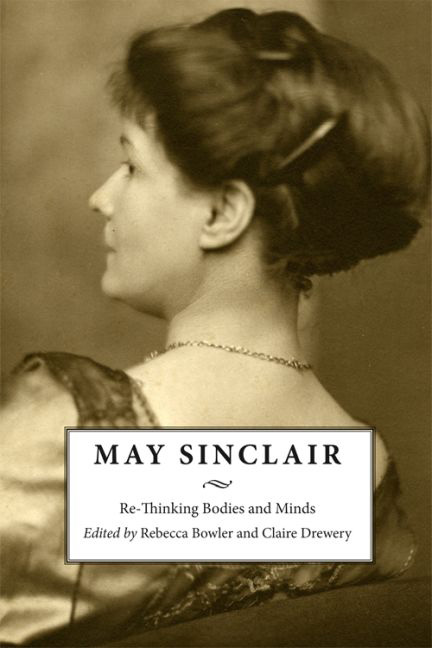Book contents
- Frontmatter
- Contents
- Acknowledgements
- Introduction: May Sinclair's Interdisciplinarity
- Part I The Abstract Intellect
- Part II Abject Bodies
- 6 Disembodying Desire: Ontological Fantasy, Libidinal Anxiety and the Erotics of Renunciation in May Sinclair
- 7 May Sinclair and Physical Culture: Fit Greeks and Flabby Victorians
- 8 Dolls and Dead Babies: Victorian Motherhood in May Sinclair's Life and Death of Harriett Frean
- 9 Why British Society Had to ‘Get a Young Virgin Sacrificed:’ Sacrificial Destiny in The Tree of Heaven
- 10 ‘Odd How the War Changes Us’: May Sinclair and Women's War Work
- 11 Transgressing Boundaries; Transcending Bodies: Sublimation and the Abject Corpus in Uncanny Stories and Tales Told by Simpson
- Notes on Contributors
- Index
8 - Dolls and Dead Babies: Victorian Motherhood in May Sinclair's Life and Death of Harriett Frean
from Part II - Abject Bodies
Published online by Cambridge University Press: 26 May 2017
- Frontmatter
- Contents
- Acknowledgements
- Introduction: May Sinclair's Interdisciplinarity
- Part I The Abstract Intellect
- Part II Abject Bodies
- 6 Disembodying Desire: Ontological Fantasy, Libidinal Anxiety and the Erotics of Renunciation in May Sinclair
- 7 May Sinclair and Physical Culture: Fit Greeks and Flabby Victorians
- 8 Dolls and Dead Babies: Victorian Motherhood in May Sinclair's Life and Death of Harriett Frean
- 9 Why British Society Had to ‘Get a Young Virgin Sacrificed:’ Sacrificial Destiny in The Tree of Heaven
- 10 ‘Odd How the War Changes Us’: May Sinclair and Women's War Work
- 11 Transgressing Boundaries; Transcending Bodies: Sublimation and the Abject Corpus in Uncanny Stories and Tales Told by Simpson
- Notes on Contributors
- Index
Summary
May Sinclair's Mothers
This chapter examines May Sinclair's representations of mother figures and maternity in her 1922 novel Life and Death of Harriett Frean. My discussion focuses specifically on Sinclair's critique of idealised Victorian motherhood in the novel, and on its portrayals of mothering practices, femininity and class. I explore Sinclair's novel as a modernist work of historical fiction, analysing its use of modernist thematic and textual strategies in reassessing Victorian values and representations. Such themes reflect a more general preoccupation in modernist women's writing with motherhood, agency and sexuality. This concern can be seen in Virginia Woolf's novels To the Lighthouse(1927) and Mrs Dalloway(1925), and Katherine Mansfield's short story ‘Bliss’ (1918), where mother-figures struggle against invisibility and idealised maternity in a patriarchal society which frequently diminishes them, and yearn to express their creativity and sexuality. In her discussion of Coventry Patmore's poem ‘The Angel in the House’ in relation to Victorian constructions of femininity, Annie Cossins concludes that Patmore ‘lauded the selfless devotion and submissiveness of the Victorian feminine ideal woman and modelled the angel on his wife, Emily, the “perfect” woman’ (Cossins 2015: 63). Patmore's poem was highly influential and continued to resonate into the twentieth century (Cossins 2015: 64). My chapter examines Sinclair's critique of the continued influence and impact of these pervasive Victorian ideals and values into the modernist period. Like Virginia Woolf, who struggled with the emotionally and creatively limiting legacies of the Angel in the House, Sinclair also battled Victorian ideals, both in her writing and her personal life. For both authors, these questions were centred on motherhood. My analysis focuses on two contrasting yet interconnected dimensions of Sinclair's portrayal of the maternal in Harriett Frean: namely the Victorian idealisation of motherhood, and Sinclair's depiction of baby farming, the dark repressed side of Victorian maternity.
Harriett Frean portrays the life of Harriett, a middle-class woman growing up during the latter half of the nineteenth century. Harriett is brought up in adherence to the traditional Victorian values of ‘beautiful behaviour’ (Sinclair 1922: 23) for women, and looks up to her parents as ideals. She foregoes marriage and motherhood, and never moves out of her parents’ house; yet memories and images from her childhood continue to return to haunt her throughout her life, demonstrating Sinclair's interest in the psychological dimensions of existence.
- Type
- Chapter
- Information
- May SinclairRe-Thinking Bodies and Minds, pp. 156 - 176Publisher: Edinburgh University PressPrint publication year: 2017



